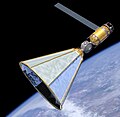A geosynchronous orbit (sometimes abbreviated GSO) is an Earth-centered orbit with an orbital period that matches Earth's rotation on its axis, 23 hours...
33 KB (3,183 words) - 15:36, 22 August 2024
A geostationary orbit, also referred to as a geosynchronous equatorial orbit (GEO), is a circular geosynchronous orbit 35,786 km (22,236 mi) in altitude...
49 KB (4,861 words) - 05:05, 11 June 2024
This is a list of satellites in geosynchronous orbit (GSO). These satellites are commonly used for communication purposes, such as radio and television...
65 KB (729 words) - 06:53, 29 July 2024
transfer orbit (GTO) or geosynchronous transfer orbit is a highly elliptical type of geocentric orbit, usually with a perigee as low as low Earth orbit (LEO)...
13 KB (1,801 words) - 19:57, 9 August 2024
A geosynchronous satellite is a satellite in geosynchronous orbit, with an orbital period the same as the Earth's rotation period. Such a satellite returns...
9 KB (1,035 words) - 09:06, 28 July 2024
Space elevator (redirect from Geosynchronous orbital tether)
gravity. The centrifugal force and the gravity are balanced at geosynchronous equatorial orbit (GEO). Above GEO, the centrifugal force is stronger than gravity...
88 KB (10,321 words) - 08:08, 18 August 2024
graveyard orbit is a supersynchronous orbit well beyond geosynchronous orbit. Some satellites are moved into such orbits at the end of their operational life...
8 KB (1,003 words) - 01:03, 3 May 2024
Thus, a geostationary orbit is defined as a geosynchronous orbit at zero inclination. Geosynchronous (and geostationary) orbits have a semi-major axis...
31 KB (3,471 words) - 19:19, 24 February 2024
200 mi) and that of the geosynchronous orbit at 35,786 km (22,236 mi). Geosynchronous orbit (GEO) Geocentric circular orbit with an altitude of 35,786 km...
17 KB (1,998 words) - 15:10, 9 August 2024
A high Earth orbit is an geocentric orbit with an apogee farther than that of the geosynchronous orbit, which is 35,786 km (22,236 mi) away from Earth...
7 KB (602 words) - 19:24, 2 August 2024
but not all geosynchronous orbits are geostationary. A geostationary orbit stays exactly above the equator, whereas a geosynchronous orbit may swing north...
57 KB (8,170 words) - 14:39, 18 July 2024
areosynchronous orbits (ASO) are the synchronous orbits for artificial satellites around the planet Mars. They are the martian equivalent of the geosynchronous orbits...
3 KB (377 words) - 22:19, 30 July 2023
than would be required from a geosynchronous orbit. Low Earth orbit A low Earth orbit (LEO) typically is a circular orbit about 160 to 2,000 kilometres...
49 KB (5,949 words) - 22:15, 26 August 2024
the boundary between MEO and HEO is the particular altitude of a geosynchronous orbit, in which a satellite takes 24 hours to circle the Earth, the same...
10 KB (1,037 words) - 19:07, 10 August 2024
2014 on-board PSLV-C24 rocket. The satellite has been placed in geosynchronous orbit. IRNSS-1C was launched on 16 October 2014, IRNSS-1D on 28 March 2015...
55 KB (4,531 words) - 06:53, 19 August 2024
Tundra orbit (Russian: орбита «Тундра») is a highly elliptical geosynchronous orbit with a high inclination (approximately 63.4°), an orbital period of...
17 KB (1,703 words) - 18:00, 6 August 2023
Orbital Sciences Corporation; their capabilities and development and construction budgets are classified. They operate in "near-geosynchronous orbit"...
5 KB (477 words) - 12:37, 14 May 2024
Altitude (section In satellite orbits)
200 mi) and that of the geosynchronous orbit at 35,786 km (22,236 mi). Geosynchronous orbit (GEO) Geocentric circular orbit with an altitude of 35,786 km...
26 KB (3,078 words) - 18:52, 16 August 2024
Space-based solar power (redirect from Orbital power satellite)
electricity. The program looked both at systems in Sun-synchronous orbit and geosynchronous orbit. Some of SERT's conclusions: The increasing global energy demand...
111 KB (12,730 words) - 04:08, 12 August 2024
have an inclined orbit around the Sun if it has an angle other than 0° to the ecliptic plane. A geosynchronous orbit is an inclined orbit with an altitude...
3 KB (338 words) - 20:20, 12 June 2024
Outer space (section Earth orbit)
concept used by the US to refer to space of high Earth orbits, ranging from beyond geosynchronous orbit (GEO) at approximately 35,786 km (22,236 mi), out to...
136 KB (13,431 words) - 12:02, 17 August 2024
Sun-synchronous frozen orbits. Orbital perturbation analysis (spacecraft) Analemma Geosynchronous orbit Geostationary orbit List of orbits Polar orbit World Geodetic...
14 KB (1,629 words) - 00:10, 31 July 2024
Geosynchronous Satellite Launch Vehicle (GSLV) is a class of expendable launch systems operated by the Indian Space Research Organisation (ISRO). GSLV...
26 KB (1,919 words) - 14:35, 26 June 2024
Syncom (category Satellites in geosynchronous orbit)
lost on the way to geosynchronous orbit due to an electronics failure. Seconds after the apogee kick motor for circularizing the orbit was fired, the spacecraft...
21 KB (2,182 words) - 12:45, 14 August 2024
Starlink (redirect from Proliferated Low Earth Orbit program)
plans with the FCC to field a second orbital shell of more than 7,500 "V-band satellites in non-geosynchronous orbits to provide communications services"...
268 KB (22,661 words) - 20:50, 26 August 2024
Sun (redirect from Sun's orbit)
Dynamics Observatory was launched in 2010 and monitors the Sun from a geosynchronous orbit around Earth. Parker Solar Probe was launched in 2018 aboard a Delta...
178 KB (20,212 words) - 22:22, 22 August 2024
satellites that have nearly consumed their orbital maneuvering fuel and are likely placed in a geosynchronous orbit. The spacecraft would conduct a space rendezvous...
73 KB (7,958 words) - 08:04, 13 June 2024
NASA (section First orbital and hypersonic flights)
with satellites in low earth orbit (LEO), geosynchronous orbit (GEO), highly elliptical orbits (HEO), and lunar orbits. The NSN accumulates ground station...
224 KB (20,758 words) - 08:07, 24 August 2024
along with another currently unidentified payload, directly to Geosynchronous orbit. It currently looks like Vulcan will be flying in the VC4 configuration...
316 KB (10,068 words) - 03:42, 26 August 2024
along with another currently unidentified payload, directly to Geosynchronous orbit. It currently looks like Vulcan will be flying in the VC4 configuration...
35 KB (717 words) - 08:46, 20 August 2024



















